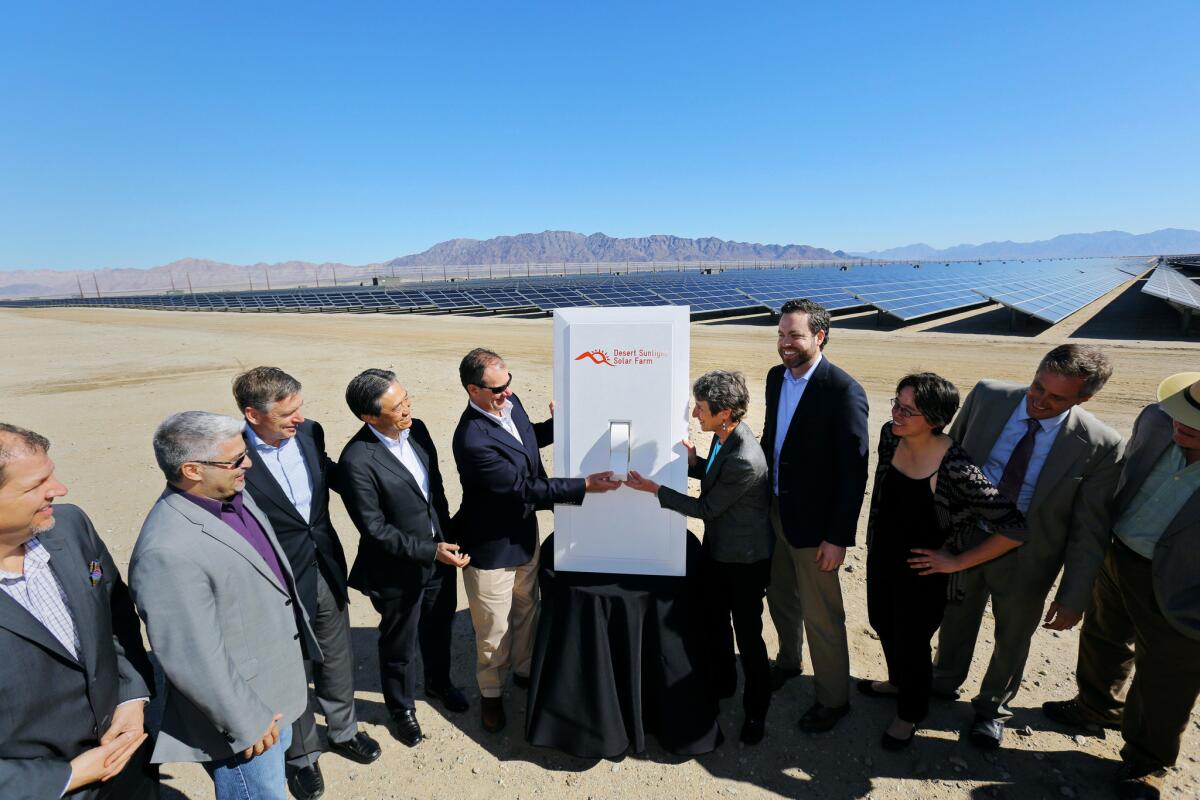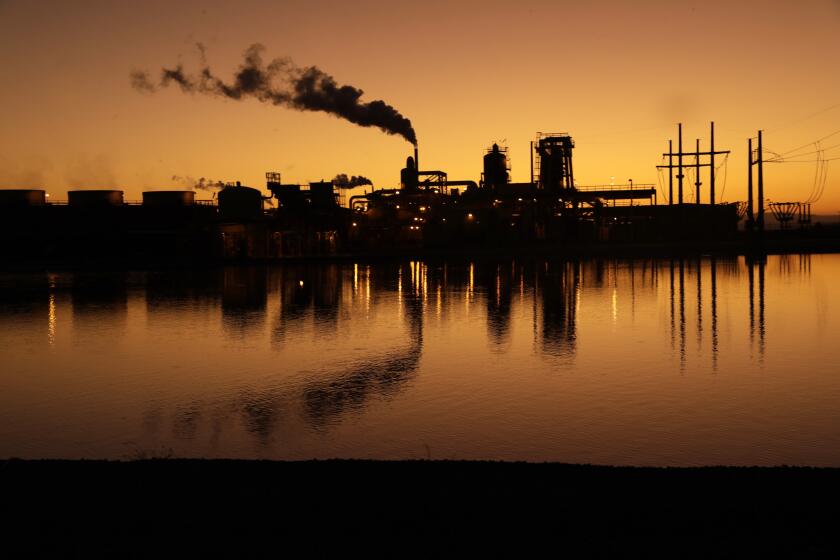Should we spend billions on clean energy? It worked during the last crisis
- Share via
Sunlight sparkled off the gleaming sea of solar panels as dignitaries from government and private industry gathered to flip a giant ceremonial light switch. At 550 megawatts, this sprawling solar farm a few hours east of Los Angeles would be the world’s largest — and federal dollars made it possible.
When it came online in 2015, Desert Sunlight was only the fifth large-scale solar energy facility in the United States. All five projects received federal loan guarantees, totaling $4.6 billion, prior to construction. Today they are a small part of a thriving U.S. solar industry that supports an estimated 250,000 jobs and has helped reduce planet-warming emissions.
Much of that funding came from the American Recovery and Reinvestment Act, the more than $800-billion economic stimulus bill passed by Congress and signed by President Obama during the depths of the Great Recession.
A decade later, as the country enters a pandemic-driven economic downturn that could rival or exceed the Great Recession, the Recovery Act provides a template for how lawmakers might drive further growth in clean energy — particularly nascent industries such as energy storage or electric vehicles.
In crafting the Obama-era stimulus, “we looked at initiatives that could in the short term put people back to work, but simultaneously would build for the long term, particularly in the context of energy, improving health and communities,” said Carol Browner, who served as Obama’s top energy and climate advisor and today is board chair of the League of Conservation Voters.
“If we hadn’t done what we did for the wind and solar industry, they probably would not have made it,” she added.

Clean energy wasn’t included in the $2.2-trillion relief package signed by President Trump last month, and it’s not clear if House Democrats will make climate change a priority in the “phase four” stimulus package being discussed now.
But depending on how long the novel coronavirus keeps much of daily life shut down, the economy may need additional support. Some kind of clean energy stimulus would be especially likely if Democrats take control of the federal government in November, with former Vice President Joe Biden winning the White House and Republicans losing their majority in the Senate.
We asked eight experts if the global mobilization to slow the pandemic might pave the way for climate action.
The Obama-era stimulus bill included $90 billion for clean energy, according to a 2016 White House report.
A big chunk of the money went to renewable power projects, including $25 billion in cash grants to developers who couldn’t take advantage of federal tax credits because the market for tax equity financing dried up.
The production tax credit for wind energy was also extended by several years. Another $1.5 billion was allocated to the Department of Energy’s loan guarantee program, which helped to launch the large-scale solar industry.
The bill set aside nearly $5 billion for a weatherization program to help low-income homes use less energy and reduce their utility bills, and $500 million for state agencies and nonprofits to train workers for energy efficiency and clean energy jobs.
The Recovery Act also made available $2.3 billion in tax credits for clean energy manufacturing, including wind turbines. According to the 2016 White House report, the share of domestically produced wind turbines installed in the United States grew from 25% before the stimulus bill to 72% afterward.
“There are certain things you can do in an economic stimulus that address the near-term need to create jobs and demand for manufacturing, demand for construction. But you can also have this very positive longer-term dynamic by creating markets for clean energy technologies, enabling producers to drive down those costs,” said Joseph Aldy, a professor at Harvard’s Kennedy School of Government who served in the Obama administration and worked with Browner to help craft the stimulus bill.
Your support helps us deliver the news that matters most. Subscribe to the Los Angeles Times.
Over the last decade, U.S. wind power capacity has tripled. Solar photovoltaic capacity has grown by a factor of 76. Costs have fallen so dramatically that solar and wind power are now two of the cheapest sources of electricity generation.
That can’t all be attributed to federal support. But researchers at Sweden’s Lund University published a peer-reviewed study in 2015 concluding that the Recovery Act “played a significant role” in increasing the country’s renewable energy installations.
Ironically, the clean energy spending that got the most attention was a $535-million loan guarantee for Solyndra, a Fremont, Calif.-based solar panel manufacturer that ultimately filed for bankruptcy. The company’s failure became a cause célèbre for conservatives opposed to government support for renewable energy, including then-presidential candidate Donald Trump.
But as of late 2014, the Department of Energy had provided more than $34 billion in loan guarantees, and companies had defaulted on just $780 million, a default rate of about 2%. The federal government had already collected $810 million in interest payments.
Aldy thinks the loan guarantee program “should have actually had more failures.” He said the federal government ought to focus on supporting technologies that have been proved in the lab or on a small scale, and need to prove themselves commercially — the kind of higher-risk clean energy projects that private industry might hesitate to fund.
What would that look like today?
Maybe energy storage technologies with a longer duration than lithium-ion batteries, which can typically bank only a few hours’ worth of solar or wind power. Maybe next-generation small nuclear reactors. Or maybe enhanced geothermal power plants, which could potentially employ some of the drilling rig operators losing their jobs as low oil prices tank the petroleum sector.
“I want something that’s truly innovative, where there may be high risk involved, where there may be private-sector reluctance to bear that risk, but where the public benefits could be really big,” Aldy said.
Jake Levine, a Los Angeles-based attorney with Covington and Burling who also worked on climate policy in the Obama White House, said he would make transportation a big part of any clean energy stimulus today. Cars, trucks and airplanes are America’s largest source of planet-warming emissions, and those emissions have proved harder to reduce than in the electricity sector.
The federal government could support various pieces of the electric vehicle supply chain: car and truck manufacturing, charging stations, even domestic production of minerals such as lithium and cobalt that are critical for electric vehicle batteries, and which the United State mostly imports from overseas. Stimulus funds could also go toward training workers to build clean cars.
A geothermal power company says it can make California’s Salton Sea the first major source of U.S. lithium production.
The energy research firm Wood Mackenzie projected Wednesday that global electric vehicle sales would fall 43% in 2020 amid the spread of the coronavirus.
“Every single automaker has staked its future on the development and sale of electric vehicles,” Levine said. “In the wake of this pandemic, we should be willing to support an auto sector capable of putting Americans back to work building those clean cars.”
Browner, too, described electric vehicle charging infrastructure as a good use of federal dollars.
“The F-150 is going to be an electric vehicle. Think about that. It’s huge,” she said, referring to the Ford pickup truck that is America’s best-selling vehicle.
“We built roads so people could sell Model T’s. Now what we need to do is build the public infrastructure for the next generation of vehicles, which can be clean,” she added.
More broadly, Browner said she would target clean energy investments toward reducing the lung-damaging air pollutants typically emitted by vehicles and power plants alongside planet-warming carbon dioxide. She pointed to a Harvard study published this week finding that people living in areas with higher smog levels are at greater risk of dying from COVID-19.
“I would look at making sure that everything is contributing to decreases in air pollution, particularly for more at-risk communities, environmental justice communities,” Browner said.
Utilities say they’re prepared to keep electricity and gas flowing while the coronavirus crisis plays out.
Solar and wind companies are also asking for federal support amid the pandemic.
The Solar Energy Industries Assn. is warning that half of the 250,000 people employed in solar could lose their jobs, and that the rooftop solar market has already slowed by more than 40% in states such as California that moved quickly to implement shelter-in-place orders. The American Wind Energy Assn. estimated that 35,000 jobs and $35 billion in investment are at risk.
Both trade groups urged Congress last month to authorize direct cash payments that would allow companies to take advantage of clean energy tax credits even if they can’t get tax equity financing, just as lawmakers did in 2009 through the Recovery Act.
Abigail Ross Hopper, president of the solar energy trade group, said the industry wants to be “really specific in what we’re asking Congress for, in terms of helping us stem the tide of job losses.”
But once the immediate public health crisis begins to subside, Hopper said, lawmakers could do more to support job creation and long-term growth. She suggested an extension of clean energy tax credits as well as federal investment in new transmission lines, to help move solar and wind power from regions where it’s abundant to energy-hungry cities where it’s needed.
“If we want to build more renewables, we need more transmission,” Hopper said.










